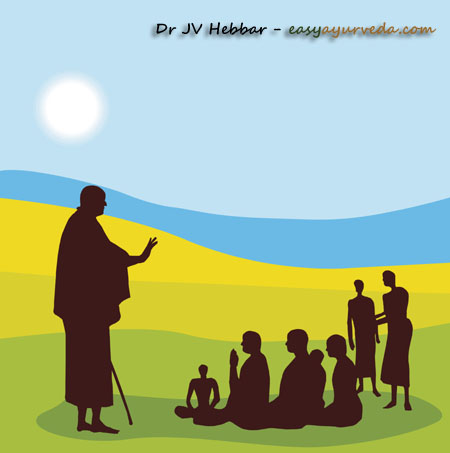Madhava Nidana Chapter 62 Yonivyapat Nidanam

This article explains Madava nidana 62nd chapter “Yonivyapat Nidanam”. Causes, pathology and symptoms of Yonivyapat are explained in this chapter. Yonivyapat means gynecological disorders.

Table of Contents
Yonivyapat Sankhya, Samanya Nidana
Number and general causes of diseases of the vaginal tract

Number of Yonivyapat – Twenty diseases of the vaginal tract have been enumerated in the rogasangraha (Ashtodariya chapter – chapter 19 of sutrasthana section of Charaka Samhita).
Etiological Factors of Yonivyapat – These diseases occur in women who indulge in unhealthy foods and habits, due to contamination of menstrual blood or disorders of menstruation, due to bijadosha (disease of the ovary and ovum) and by influence of gods. (1)
Read – Charaka Chikitsa Sthana 30th Chapter – Yoni Vyapat
Vataja Yoni Vyapad (5 in number)
Caused due to predominance of vata – Udavarta, Vandhya, Vipluta, Paripluta, Vatala yoni
Udavarta Yonivyapat – In this condition the woman discharges frothy menstrual blood with difficulty (pain).
Vandhya Yonivyapat – the woman in whom the menstrual blood has been destroyed (who has stopped menstruating and is sterile) is known as Vandhyā. Such a condition is known as Vandhya Yonivyapat.
Vipluta Yonivyapat – In this condition the woman always has pain (constant pain).
Paripluta Yonivyapat – In this condition the woman experiences severe pain during sexual intercourse.
Vatala Yonivyapat – It is a condition in which the vagina afflicted by aggravated vata is rough and stiff and is associated with pain and pricking pain.
In the first four conditions (explained above) also there will be vataja types of pains (and other symptoms of vata increase). (2-4)
Read – Vaginitis: Ayurvedic Treatment, Medicines, Home Remedies
Pittaja Yoni Vyapad (5 in number)
Caused due to predominance of pitta – Lohitaksaya, Vamini, Prasramsini, Putraghni, Pittala yoni
Lohitaksaya Yonivyapat – It is a condition in which the woman has large quantities of menstrual flow along with burning sensation. There is severe loss of blood and hence this condition is known as Lohitaksaya.
Vamini Yonivyapat – In this condition both the ovum and menstrual fluid (blood) are expelled out from the vagina along with vata.
Prasramsini Yonivyapat – It is a condition in which the vagina is displaced from its place repeatedly due to irritation. This woman gives birth to a child with great difficulty.
Putraghni Yonivyapat – The woman who repeatedly undergoes abortion after having conceived the embryo due to severe loss of blood is said to be suffering from Putraghni Yonivyapat.
Pittala Yonivyapat – In this condition there will be severe burning sensation and suppuration in the vaginal tract and is accompanied with fever.
In the first four conditions (explained above) also there will be pittaja types of pains (and other symptoms of pitta increase). (5-7)
Read – Garbhasrava, Garbhapata – Meaning, Causes, Ayurveda Treatment
Kaphaja Yoni Vyapad (5 in number)
Caused due to predominance of kapha – Atyananda, Karnini, Acarana, Aticarana, Shleshmala yoni
Atyananda Yonivyapat – In this condition the woman does not experience pleasure during coitus.
Karnini Yonivyapat – In this condition a ring-like muscular mass is produced by vitiated kapha and blood inside the vaginal passage.
Acarana Yonivyapat – In this condition the woman (uterus) discharges much earlier than the man (ejaculates the semen) during coitus.
Aticarana Yonivyapat – In this condition the woman (uterus) discharges only after excessive and prolonged coitus. Both these conditions (acarana and aticarana) will not retain the seed / sperm (i.e., women having these two conditions do not conceive).
Shlesmala Yonivyapat – In this condition the vaginal passage of the woman will be sticky; will have severe itching and coldness.
In the first four conditions (explained above) also there will be kaphaja types of pains / symptoms (and other symptoms of kapha increase). (8-10)
Read – Beejopaghata: Sperm Damage And Azoospermia In Ayurveda
Sannipataja Yoni Vyapad (5 in number)
Caused due to predominance of all three doshas – Sandi, Andali, Vivrta, Sucimukhi, Tridoshaja yoni
Sandi Yonivyapat – It is a condition in which the woman would not menstruate (not menstruating), not have breasts or have small and under-developed breasts and will have roughness of the vagina during coitus.
Andali Yonivyapat – In this condition the young woman would have a prolapsed vagina (uterus) caused due to coitus with a person having a big or stout penis.
Vivrta Yonivyapat – In this condition the vaginal passage (opening) of the woman would be very wide.
Sucivaktra / Sucimukhi Yonivyapat – It is a condition in which the woman would have a very narrow vaginal (uterine) passage.
Tridoshaja Yonivyapat – In this condition caused due to simultaneous vitiation of all three doshas, the causative factors and symptoms of all the three doshas will be found together.
In the first four conditions (explained above) also there will be tridoshaja types of pains / symptoms (and other symptoms of tridosha increase).
All these five kinds of tridoshaja yonivyapat are said to be incurable.(11-13)
Thus ends the chapter on Yoni vyapat in Madhava Nidana text written by Acharya Madhavakara.










